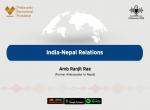Tipaimukh dam projected to be made at the cost of around Rupees 9000 crores with the aim of generating around 1500 MW of electricity and moderate floods downstream has again become a controversial political issue between India and Bangladesh. With India and Bangladesh sharing 54 rivers amongst them water has always been a point of contention between the two. The rock filled hydro electric dam to be located on the border of Kolashib district of Mizoram and Churachandpur district of Manipur near the confluence of Tuivai River and the Barak River has met with a lot of resistance on both sides of the border with a slew of objections from the Bangladeshi side as well as protests from the North Indian states.
The issue has been a controversial one since its inception and more so now with growing skepticism towards the environmental impact of a dam in general, highlighted by a report by the World Commission on Dams in 2000 that brought into focus the environmental consequences leading to large scale displacement of people as well as highlighting the importance of taking the view of the people in decisions on such projects.
Over the years it has dominated the political, civil society and media discourse. Although it has time and again been stressed by India that the project is a run of the river one aimed at controlling floods downstream and generating power with no intention of diverting any water from the natural flow of the river for irrigation, the main contention of Bangladesh and the North Eastern states has been that no joint assessment has been made on the project to review the environmental impact of the project downstream.
It was in the 1970’s that the project formally entered under the ambit of the Joint River Commission (JRC). However historically there have been differences over facts on the issue, firstly whether Bangladesh consented to building the dam or not, secondly whether it was jointly studied and a report was submitted? Thirdly, whether the Tipaimukh site was recommended by the Joint Committee of Experts constituted by the JRC and finally over the lack of communication by India over the project.
However Indian Minister for Water Resources Pawan Kumar Bansal in a meeting with the Bangladeshi journalists on June 2012 claimed that it was Bangladesh that proposed the Tipaimukh project in 1974 and provided relevant documents of the minutes of the sixth JRC meeting held in November, 1973 that states that:
“The commission considered the study of Barak Dam project in the context of floods in India and Bangladesh and recommendation that this project be reviewed by the Superintending Engineers of Bangladesh and India, for flood moderation and protection to Sylhet, Cacher and adjoining areas,” the minute said.1
The High Commissioner of Bangladesh to India Tareq A Karim in his meeting with journalists in June 2012 observed that between 1972 and 1982, the rhetoric was same but it changed in 1982 when it was stated that the project would be harmful for Bangladesh. 2
However the issue raised its head again in the agenda of the Joint River Commission in 2005 with India assuring Bangladesh to share the design of the project. Further, in 2007 the North Eastern Power Corp commissioned the Agricultural Finance Corporation of Mumbai to carry out an Environmental Impact Assessment (EIA) report in 2007. Following which an environmental clearance was given by the Ministry of Environment and Forest, Government of India on October 24, 2008. However Bangladesh and the North Eastern states disapproved the report as being unilateral and one which did not include them as they would be bearing major environmental impact due to it.
The opposition to the dam gained new momentum especially after the signing of a Memorandum of understanding (MoUs) among Manipur Government, National Hydro electric Power Corporation (NHPC) and Satluj Jal Vidyut Nigam Limited (SJVNL) on April 28, 2010 and the signing of the Promoter’s Agreement with the purpose of setting up a Joint Venture Company (JVC) between the Government of Manipur, NHPC Ltd and Sutlej Jal Vidyut Nigam Ltd (SJVN) on October 22, 2011.
Issues against the Project
The Bangladeshi civil society groups, media as well the opposition parties have come out strongly against the project especially after the signing of the Promoters Agreement and have put pressure on its government to take up the issue with India. Although India has assured Bangladesh that it would not have any adverse impact on the country but a strong sentiment against the dam is already prevalent there. Primarily Bangladesh is concerned with the environmental impact of the project as well as the ability of the project to control floods. It fears greater exposure to floods during monsoons and low flows during the lean season. They also argue that as the river is an international river and the decisions should be taken in accordance with international law. They view the decision of the Indian Government in going ahead with the project as one in which India has taken a unilaterally decision which is unacceptable. Therefore to seek clarifications from the Indian government Mashiur Rahman and Gowher Rizvi advisors to Sheikh Hasina to came to India in December 2011. Following which Gowher Rizvi wrote an article in Daily Star calling for a rational and scientific discussion on the project and tried to clarify certain misconceptions about the project. This was followed by a visit by a group of 13 member Bangladeshi team including 10 media persons led by Bangladesh External Affairs Publicity Wing Deputy Director Mohammad Zashimuddin who came at the invitation of the Indian government to assess the effects of the multi purpose hydro electric Tipaimukh project by visiting the site and to dispel any misgivings about the project that have been generated and agitating the minds of people in Bangladesh.
India on its part has been giving repeated assurances to Bangladesh about the safety of the project and it not adversely impacting it in any way. Tipaimukh features in the Joint Communiqué that was signed between India and Bangladesh during Shaikh Hasina’s visit in 2010. The Indian government in the 37th meeting of the Joint Rivers Commission in March 2010 gave the assurance that they would not take any step under the Tipaimukh project that might harm Bangladesh. The Indian PM during his September 2011 also gave the same assurance.
On the official level however there is more convergence between the two governments especially about the nature of the project and it being a run of the river project with no intention of India to divert any water from the Barak River. The Foreign Affairs advisor to the Government of Bangladesh Gowher Rizvi in his article in the Daily Star stresses on the adverse impact of the project on India rather than Bangladesh and states “the project is located nearly 140 miles away from Bangladesh borders and it would appear that much of the environmental impact -- flooding, submerging of land, displacement of people, disruption of livelihood and destruction of wild animal habits, etc. -- will be largely confined to India and is unlikely to hurt Bangladesh because of the distance” On grounds of safety it has reiterated that due to the distance of the project from Bangladesh it will do more harm to India than Bangladesh.
There are serious concerns regarding the safety of the dam as it is in an area which is a geologically sensitive that is highly prone to earthquakes that in turn raises questions on its safety. It is one of the most seismo-tectonically risky areas in the world where the epicenter of earthquakes of magnitudes 8+ have been measured over the past 50 years. The proposed Tipaimukh dam axis falls on a ‘fault line’ potentially active and possible epicenter for major earthquakes.3
The region is also known to be ecologically sensitive as well as topographically fragile and the impact of the project is supposed to have an adverse impact on the hydrology, agriculture, fisheries, ecology and economy of both India and Bangladesh. The potential risks for both the countries are high which would lead to large scale submergence of land and displacement of people. A large area of land nearly 311 sq. km. would be permanently submerged in India, of which around 229.11 sq. km. areas are reserve forest, remaining are agricultural and settlement land.4 In addition it would also involve large scale felling of trees and loss of biodiversity.
There are concerns about the water flow in the river as a result of the hydrological impact that inflict an artificial pattern of flow variations in the river.5 The dam to be built on river Barak assumes the name of Surma and Kushiara as it flows into the North Eastern part of Bangladesh and is largely dependent on the river Barak for its water flows. The impact of the dam operation is said to have changes in the downstream hydrology with changes in total flows, seasonal flows, short term fluctuations in flows and change in extreme high and low flows. 6 It has been argued that as Barak-Surma-Kushiyara is a continuous river that empties into the Bay of Bengal through the Meghna River, therefore any changes in the water flow is going to impact the flow into the Bay of Bengal. There is also the fear of construction of Phuler Tal Barrage in Assam which would lead to diversion of water but that has been denied by the Indian government.
The Dam has been projected to be built as a run of the river project but that claim has been refuted by Bangladesh on the grounds that although the dam doesn’t divert water for irrigation but building a dam hampers the natural flow of the river around which the life, livelihood and ecosystem of the Hoar region is built.7 Any change in the natural flow pattern around which the farmers of the Hoar region prepare there land for Boro cultivation will be altered that would in turn lead to damage to Boro production in the Sylhet region according to Bangladeshi experts, which would lead to losses of around 1000 crores a year. According to the sixth Flood Action Plan prepared by Bangladeshi experts it would be disastrous for riverine ecology and biodiversity of the region. There is also the fear of construction of Phuler Tal Barrage in Assam which would lead to diversion of water but that has been denied by the Indian government.
In addition to Bangladesh having a variety of concerns regarding the Tipaimukh project, the North Eastern states of India are also in opposition of the project. Many Civil Society groups in the region believe that the proposed dam if built, would in turn unleash catastrophe in both the upstream and downstream areas of the river.8 The dam would lead to the relocation of the people of Manipur whereby the 9,126 sq km area in Manipur in which the indigenous population of the Zeliangrongs and Hmars Communities would be permanently displaced and deprived of livelihood. Therefore instead of making one large dam it has been suggested to make around 130 hydel projects across the region that would ensure local participation as well a help in the regions economic growth. The Sinlung Indigenious People Human Rights Organisation (SIPHO) has also been against the project and considers it as one that has overlooked the recommendations of the WCD (World Commission on Dams) as well as one that is not considered with the well being of the indigenous people of the region who would be displaced.9
Therefore the main concerns of the North Eastern States are the displacement of people especially the indigenous population, vast submergence of land including forestland with its biodiversity, possible earth quake risks of that could have devastating effect in the region. Meanwhile the objections on the Bangladeshi side consist of river drying and devastation of wetland (Hoar), possible flood in summer/winter in lowlands causing damage to agriculture. For Bangladesh the lack of transparency on the project and the lack of clarity on the water release schedule raise doubts over the change of flows of the downstream areas.
The Tipaimukh dam has over a span of a few months raised serious resentment in Bangladesh since the signing of a Promoter Agreement on October 22, 2011 with a section of people coming out against it with issues of non inclusion in decisions impacting them. Although the Indian government has been forthcoming in clearing misconceptions regarding the project more exchange of information is required. In addition the Joint Survey with Bangladesh to access the impact of the Project on it is a step in the right direction before such issues are exploited by vested interests for their own political benefit. However the concerns of the North Eastern States should also be addressed and not sidelined.
Endnotes
- Vrithli (June 2012) Tipaimukh dam ‘only if Dhaka agrees’ URL: http://virthli.com/2012/tipaimukh-dam-only-if-dhaka-agrees/
- ibid
- Bangladesh India: No to Tipaimukh
- Impact Study of Tipaimukh: Final Report
- Al-Mahmood, Syed Zain (July 2009) Follow-up: The Dam Documents, Star Weekend Magazine Vol. 8 (79)
- Hossain, M. Anowar , Tipaimukh Dam of India; Probable disaster for Bangladesh, URL: http://archive.riversymposium.com/2006/index.php?element=06HOSSAIN+MAnowar
- Khalequzzaman Md. Tipaimukh Dam: Bangladesh erspective, India waterportal, URL: http://www.indiawaterportal.org/post/22888
- The Times of India (March, 28, 2012) Build Micro Hydel projects instead of Tipaimukh dam
- Bangladesh, India: No to Tipaimukh
Published Date: 23th July 2012









Post new comment